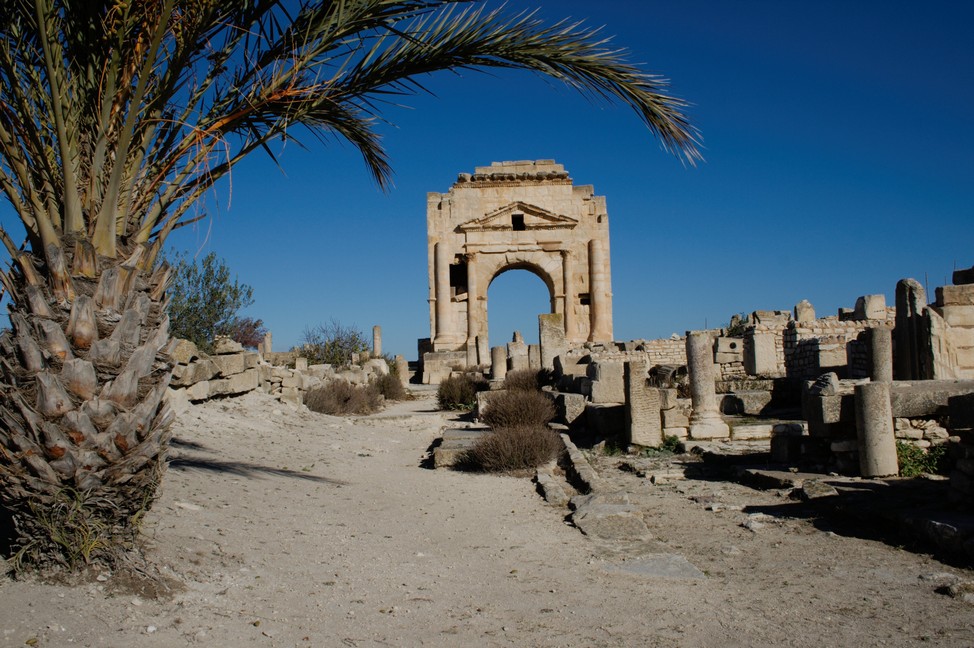Kairoun we are coming. Again and again we stop and appreciate the wonderful landscape. The inner city of Kairouan is very compact and not very large. You can reach all the tourist attractions by foot. Around the city runs a ring road. We park in front of the great mosque.
The impressive three-tiered minaret is the oldest in North Africa. The base is from the 8th century and was built of Roman stones. The ribbed dome with copper balls only came in the 13th century. We enter the mosque yard from the side entrance.

On the south side of the courtyard are 17 heavy cedar doors decorated with carvings leading to the huge prayer room. There is no access for non-Muslims. Here we await our guide. He tells about the mosque and Islamic daily routine, about prayers and when they are held.
In the mosque there are prayer rooms inside, a courtyard for washing and a tower for the muezzin to call. 128 steps, 33 metres high, and the muezzin had to climb up here five times a day in former times, because we have to pray five times a day. First time at half past six in the morning he calls – that depends on the sun and changes a little every day. In winter, at six or quarter past six, but in the summer, in July and August he called at half past four approximately, because the sun rises at five clock.
At the first muezzin you have an hour time to pray, when the sun rises, but in the morning, people sleep and might not listen to maybe the first call of the muezzin, then he calls an hour and a half later, and then each quarter of an hour. If you cannot hear it the first time, it will be the fourth or 6 time you will be woken up. The next time it calls 10 minutes after 12 o´ clock, the third time at three o´clock, the forth time when the sun goes down and the fifth time when it is dark already.
The size is impressive. The courtyard measures 135 by 80 meters. Young female Muslims gather in the courtyard. Women also have access to the Great Mosque. Their hours of prayer, however, are different to those of the men. We are impressed by the interior. As non-Muslims, we must not enter, but can see through the gate. A forest of columns of marble, granite and Porphyr with capitals of various origins – Roman – Byzantine – Arab – supports the ceiling. The furniture was brought in from Baghdad the 9th Century.
The sophisticated lighting is very dim. The courtyard is lined with marble, revolved by three sides of column supported arcades. The huge surface area of the courtyard was also utilized to collect rainwater, which was used for drinking and ablutions. The water flowed through a particle filter in the centre of the courtyard into cisterns beneath. Through several well openings, it was again raised.
We walk through the Medina of Kairouan. It is restored perfectly with 20 watch towers, and with several gates surrounded by a city wall that encircles the old city to 3.5 km in length. So walking through the streets we see further numerous mosques. We see the minaret of the “three doors Mosque” built in 1440. It is one of the oldest mosques in the city and was built by an Andalusian immigrant. Non-Muslims can only marvel at the three entrance doors and the huge, Moorish-style, held facade, carved Kufic fonts, arabesques and ornamental decorations.

We like the craft stores that are open to the road, where cloth is woven and wood is carved.
We are sorry for the poor camel in the well Barouta. Under the Dome at the first floor it drives the cogs of a large pumping station. The poor animal has to go blindfolded in a circle around the fountain. Pilgrims, but more tourists tend to buy here holy water from the legendary source that was emerging at the founding of Kairouan. Fairly concerned, we leave the unspeakable place. Such an attraction will not be supported by us.

We end the day in the courtyard of the hostel of Kairouan.







